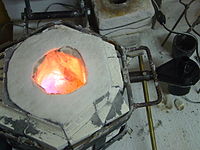Gas burner
This articleneeds additional citations forverification.(May 2016) |




Agas burneris a device that produces a non-controlledflameby mixing afuel gassuch asacetylene,natural gas,orpropanewith an oxidizer such as the ambientairor suppliedoxygen,and allowing forignitionandcombustion.
The flame is generally used for the heat, infrared radiation, or visible light it produces. Some burners, such asgas flares,dispose of unwanted or uncontainable flammable gases. Some burners are operated to producecarbon black.
The gas burner has many applications such assoldering,brazing,andwelding,the latter usingoxygeninstead of air for producing a hotter flame, which is required for meltingsteel.Chemistry laboratories use natural-gas fueledBunsen burners.In domestic and commercial settings gas burners are commonly used ingas stovesandcooktops.For melting metals with melting points of up to 1100 °C (such ascopper,silver,andgold), a propane burner with a natural drag of air can be used. For higher temperatures, acetylene is commonly used in combination with oxygen.
Flame temperatures of common gases and fuels[edit]
| Gas / Fuels | Flame temperature |
|---|---|
| Propanein air | 1980 °C 3596 °F |
| Butanein air | 1970 °C 3578 °F |
| Woodin air (normally not reached in awood stove) | 1980 °C 3596 °F |
| Acetylenein air | 2550 °C 4622 °F |
| Methane(natural gas) in air | 1950 °C 3542 °F |
| Hydrogenin air | 2111 °C 3831 °F |
| Propanewith oxygen | 2800 °C 5072 °F |
| Acetylenein oxygen | 3100 °C 5612 °F |
| Propane-butanemix with air | 1970 °C 3578 °F |
| Coalin air (blast furnace) | 1900 °C 3452 °F |
| Cyanogen(C2N2) in oxygen | 4525 °C 8177 °F |
| Dicyanoacetylene(C4N2) in oxygen (highest flame temperature) | 4982 °C 9000 °F |
The above data is given with the following assumptions:
- The flame isadiabatic
- The surrounding air is at 20 °C, 1 bar(atm)
- Complete combustion (no soot, and more blue-like flame is the key) (Stoichiometric)
- Peak Temperature These notes are not assumptions, and need more clarification:
- Speed of Combustion (has no effect on temperature, but more energy released per second (as adiabatic) compared to normal flame)
- Spectral bands also affect colour of flame, as of what part and elements of combustion
- Blackbody radiation (colour appearance only because of heat)
- Atmosphere - affects temperature of flame and colour due to the atmospheric colour effect
Flammability limits and ignition temperatures of common gases[edit]
| Flammability limitlower, in % | Flammability limitupper, in % | Ignition temperatures | |
|---|---|---|---|
| Natural gas | 4.7 | 15 | 482-632 °C |
| Propane | 2.15 | 9.6 | 493-604 °C |
| Butane | 1.9 | 8.5 | 482-538 °C |
| Acetylene | 2.5 | 81 | 305 °C |
| Hydrogen | 4 | 75 | 500 °C |
| Ammonia | 16 | 25 | 651 °C |
| Carbon monoxide | 12.5 | 74 | 609 °C |
| Ethylene | 3.4 | 10.8 | 490 °C |
(Atmosphere is air at 20 degrees Celsius.)
Combustion values of common gases[edit]
| Gas | Combustion value | |
|---|---|---|
| (Btu/ft³) | (MJ/m³) | |
| Natural gas (methane) | 950 to 1,150 | 35 to 43 |
| Propane | 2,572 | 95.8 |
| Propane-butanemix | 2,500 to 3,200 | 90 to 120 |
| Butane | 3,225 | 120.1 |
References[edit]
- Pocket Guide to Fire and Arson Investigation,second edition, FM Global, Table 1, 2, and 3
- Gas burnerat the Encyclopædia Britannica

